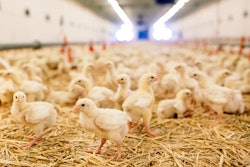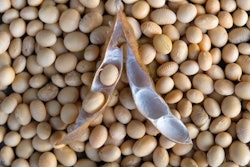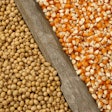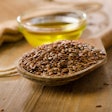
Steven Kilger: Hi, everyone. My name is Steven Kilger. I'm the managing editor of Feed & Grain and the host of the Feed & Grain Podcast. Thank you so much for joining me today as we dive deep into the issues impacting feed manufacturing, grain handling and allied industries.
Today, Dr. Adam Krull, senior nutritionist at Pioneer joins the podcast to talk about Plenish High Oleic soybeans, talk about new research highlighting their advantage and dairy cow feed, why they're being roasted for those dairy rations, and how grain elevators might find a niche in carrying them.
Before we start, if you're listening to this on a podcasting app, please rate us and subscribe. If you're listening online, sign up for the Feed & Grain Industry Watch Newsletter, to see the latest podcasts and stay up to date with all the news from around the industry. Now, on to the show.
Hello, Adam. Thank you for joining me on the podcast today.
Adam Krull: Really happy to talk to you.
Kilger: Thank you for taking the time. You're here today because recently, well you didn't do the research, but you put out a release on the benefits of Plenish High Oleic soybeans in the dairy industry and what it can do for increasing milk production within cows. High Oleic soybeans are just kind of amazing because they give more profit to farmers and, hopefully, more profit to grain elevators, and a bunch of different people can really benefit. But we need all the press we can about out there. So thank you for coming and talking to me today. Can you kind of provide a brief overview of what Plenish High Oleic soybeans are and what their benefits are?
Krull: Plenish High Oleic soybeans are nothing that's necessarily new, they've been around for close to 12 years. Originally designed for the food industry, because the change in the oil fatty acid profile with more oleic fatty acids and less linoleic fatty acids had basically unique cooking properties and increased oil life in fryers in different industries. That's where the product was originally intended for. A couple of years ago, in 2018, a couple of university researchers looked at how they beat various fatty acids. Looked at feeding Plenish High Oleic soybeans and found that they can have some really positive benefits to dairy with increasing milk fat. And we've kind of run with it from there.
Kilger: It's crazy that even 12 years later, we're still finding new uses for it. That's amazing. What are some of the key benefits that dairy farmers can expect from using Plenish High Oleic soybean, especially in terms of fat production in their milk, feed costs and feed efficiency?
Krull: That's really interesting, because some of the original research was really focused on this concept that linoleic acid in dairy cattle, when you feed too much of it, and there's a lot of linoleic acid in corn and soybean products and byproducts. When we feed too much linoleic acid to dairy cattle, we cause a condition called milk fat depression, so you actually lower the amount of milk fat that cows produce. With Plenish High Oleic soybeans, when we replace that linoleic with oleic, we reduce our risk. We see when we feed them, at least some of the original research showed, we get a nice increase in milk fat.
That was 2018. More farms have started feeding it. Some of the other dynamics within the feed industry, especially during the pandemic, when things like palm fat were hard to get and very expensive, some of the dairies started just using the fat from these Krull Plenish soybeans and found that it created a cost-saving piece as well. Not only were we getting some bonus increase in milk fat, and milk fat is worth a lot to a dairy, we saw a lower feed cost as well.
Now some of the latest research here in the last year or so, we've shown these cattle are becoming more efficient as well. Their feed intake per pound of milk production is becoming better, so they'll be getting more efficient. We just keep finding more and more and more benefits to these High Oleic soybeans. and the benefits of farmers on their turn on investment is really, really good. We've seen increases of over $1 per cow per day of increased profitability. When you start putting the numbers on some of these dairies, that's a lot of extra money.
Kilger: In some of the research, roasting the soybeans has an effect on the properties. Is this a common practice? Why are people doing this?
Krull: That's a great question. The most common questions we get asked. All soybeans aren't really popular historically for feeding because. you know, it was more efficient to take the oil out, and then feed the byproduct. But there are places in the country that do that, especially on the East Coast where a lot of farms really like feeding roasted soybeans.
The reason roasting is popular is because it does a number of things. One of the most profitable outcomes of it is the increase in the rumen bypass protein in soybeans. It basically doubles the amount of rumen bypass protein, which is a much more expensive protein. In that process, it also destroys the urease enzyme. That's an important piece of the equation, because whole soybeans, if they're not roasted, contain a urease enzyme. If you have urease in the diet, for these dairy cattle, that urease enzyme will split it and turn it into ammonia, which can be toxic.
So roasting provides some benefits there the bypass protein makes it safer to feed and increases palatability shelf life before they can become rancid otherwise. We were really recommending roasting. I know there are some logistical hurdles associated with that. A lot of farms putting on-farm roasters, there are mobile roasters out there. A lot of those things work for dairies under 1,000 cows. As they get bigger and bigger, dairies want to do and it gets to be a little bit of a capital expense.
It's one of the things where there is some ongoing research, can we feed these unroasted? Adam Locke at Michigan State is doing it right now. We've seen some of the preliminary stuff, it looks like even without the benefit of the roasting, on the protein side of it, the roasting also seems to be having an effect on how the cattle absorb and utilize the oil side of it too. There are other benefit. We're not sure the mechanism necessarily gets to there are other benefits to roasting and did increase the value of return on investment are the same. So yeah, at this point, it's definitely a recommendation for growth, if possible.
Kilger: It's really cool. It's exciting research. Obviously, grain elevators who want to carry Plenish soybeans -- either to transfer to other places or to sell them back to their own customers for their own feeding purposes, whatever it happens to be -- there are some steps to go through. What kind of suggestions for grain elevators who want to offer this both to their customers and also want to kind of handle this type of product as it comes in?
Krull: Originally, when this was meant for just the food side, we, and this was outside of my area of expertise, I'm more on the cattle side of things, but Roger Theisen at Pioneer worked a long time setting up receiving locations for Plenish soybeans. When they would do that you had to have, obviously, a segregated bin to store them. We would supply the elevator with basically a NIR type of a system that would analyze every load of soybeans to make sure that they did have the profile, you know, they weren't just to monitor the soybean. Originally, when it was just that part of the equation, that was fairly easy, we had some large receiving locations.
As we've transitioned a good chunk of the soybeans toward the dairy industry, we have a lot of small elevators that want to provide a product to the dairy farmers. So there are some of the same pieces of the equation, this time on a little bit of a smaller scale. We still need to set you up with a NIR machine to make sure you're getting the Oleic soybeans, there's really not a whole lot to it other than making sure it's segregated. We don't want these intermixed with commodity soybeans.
When a farmer goes to plant these, they have to have a dedicated final location set. They need to say, these beans are going to this elevator and all the beans are going there ahead of time, so the elevator has the ability to set a premium on the High Oleic soybeans.
We publish all the premiums on our website, you can what is being offered and I think last year, they ranged from 85 cents a bushel up to $2 a bushel premium at these receiving locations. On the dairy side, there's probably the step in the elevator -- we have some elevators that have the ability to do roasting there so they can take in the beans, keep them segregated, roast them, and sell them back to the dairy farm.
Kilger: That's a big advantage. So dairy farmers don't have to put in their own roasters. That roasting ability for your customers, that's a big advantage. Are there specific best practices or guidelines for farmers and where can they kind of get more information if they need it? D o you have some resources on your site? Is there a good central location to find info?
Krull: Yeah,you can find some basic information on the varieties on pioneer.com. There's a whole page dedicated to Plenish. But probably the best thing would be to go through your local sales rep. Originally, the majority of soybeans we put out to match where our central receiving locations are. As more and more dairies are interested in a lot of these dairies are further north than we ever anticipated.
If you're interested in doing it, make sure that we have a soybean that matches the maturity that you are in and you have that ability. Today, the soybeans are only available in a roundup-ready version, they're not available in the new Enlist E3 soybean that will be coming. But depending on your feed pressure, that can be an issue if you have certain pressures in that area.
Kilger: Very good information. It's always best to call your local sales representative and just talk it out. They'll be able to answer any questions you have without you having to mess around with searching on the internet. We've already mentioned a few cool research initiatives and future developments that are going to happen down the line as we figure out all the advantages of High Oleic soybeans. Are there any other ones that are exciting, that you can see happening or any research that's currently going on that you're excited about?
Krull: On the dairy side, there's a lot of really interesting things happening. This roasting, some interesting pieces of how that's working, we'll learn more. They're probably one of the biggest things that's being worked on and will have a lot of benefit for the dairy industry. For nutritionists who want to put this in rations, the current ration balancing software doesn't necessarily know how to handle changing fatty acid profiles in predicting performance.
We're supporting an initiative with Cornell to try to update the ration balancing model to show that if we switch to a different fatty acid profile, we can predict that this is the response that we will see until nutritionists look at balance rations that is an important piece of them to is this an economical thing to add to the ration or not add and being able to predict the performance will be very helpful.
Kilger: Definitely. Well, those are questions I have. Thank you again, Adam, for coming on and talking to us. I really appreciate you taking the time. And thank everyone out there for listening. We'll see you next time.
In this episode of the Feed & Grain Podcast, Steven Kilger, managing editor of Feed & Grain, delves into the revolutionary world of Plenish High Oleic soybeans and their game-changing effects on the dairy industry. Steven is joined by Dr. Adam Krull, senior nutritionist at Pioneer.
Dr. Krull sheds light on the origins of Plenish High Oleic soybeans, initially designed for the food industry, and how their unique fatty acid profile sparked new possibilities in dairy feed. The podcast unfolds the journey of these soybeans, from their discovery to the recent research that reveals increased profitability for farmers.
.jpg?auto=format%2Ccompress&crop=faces&fit=crop&h=48&q=70&w=48)














